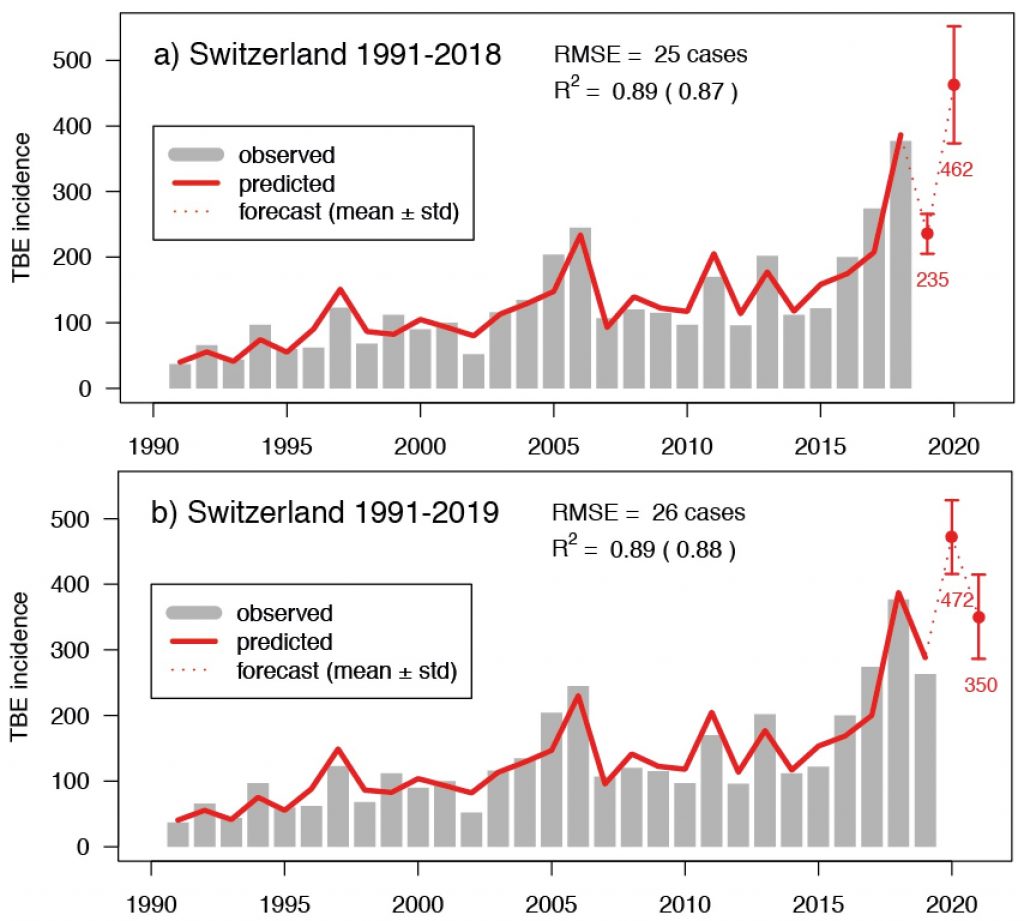Background
A long-term forecast of human tick-borne encephalitis (TBE) incidence for the next years has been on the research agenda of epidemiologists since the discovery of this tick-borne zoonosis. So far, no attempts have been made to operationally forecast the TBE incidences for the Central European countries Austria, Germany, and Switzerland. With the recently published statistical model by Rubel et al. (2020), such forecasts can now be easily calculated with a minimum number of publicly available predictors. The first TBE incidence two-year forecasts for 2019 and 2020 were created in spring 2019 (Rubel and Brugger, 2020a). One year later, these forecasts for the whole of 2020 were re-calculated and extended to 2021. In addition, the TBE incidence forecasts for 2019 were verified with the official TBE cases numbers (Rubel and Brugger, 2020b).Results and discussion
The national TBE time series were subjected to spectral analysis. The resulting power spectra indicate which predictors are responsible for the trend, the low-frequency, and the high-frequency oscillations. Therefore, the increasing trend can be mainly associated with the demography of the increasing human population and their vaccination coverage. The low-frequency oscillations (10 years) are associated with the decadal changes of the large-scale climate in Central Europe reinforced by the socio-economic predictor net migration. The high-frequency oscillations (2–3 years) are associated with fluctuations of the natural TBE transmission cycle between small mammals and ticks, which are driven by beech fructification. As described in detail by Rubel et al. (2020), peaks in the TBE incidence series are mainly caused by high beech fructification indices (mast seeding) two years prior. This means that a two-year forecast can be made. However, unpredictable extreme weather events can result in actual TBE case numbers deviating from the forecasts in a few years.
The TBE forecasts are presented as national time series 1991-current. The time series for Switzerland are shown here as an example. As shown in the figure, the Swiss TBE forecast model was fitted to the observed TBE cases with an explained variance of R2=89% (adjusted variances R2=87-88%) and root-mean-square errors of RMSE=25-26 cases. In spring 2019, 235±30 TBE cases were forecasted for the whole of 2019 (Rubel and Brugger, 2020a). A year later, the Swiss Federal Office of Public Health published exactly 263 TBE cases for 2019. Fortunately, this value lies within the forecast interval. For 2020, 465±91 TBE cases were forecasted, which was updated to 472±56 cases with the forecast made in spring 2020. A high or even a maximum number of TBE cases is therefore expected for 2020. In addition, 350±62 TBE cases were predicted for 2021.
The corresponding TBE incidence forecasts for Austria results in 156±19 TBE cases for 2020 and 131±23 TBE cases for 2021. For Germany 663±95 TBE cases for 2020 and 543±112 TBE cases for 2021 are expected. A manuscript describing these forecasts was recently submitted for publication and can be found on the preprint server medRxiv (Rubel and Brugger, 2020b). The reliability of the TBE incidence forecasts can be assessed in 7-10 years if the number of forecasts allows a statistically significant verification. Until then, it remains to be shown whether the forecasts will come true or not.

Figure: TBE incidence time series for Switzerland (grey bars) and fitted TBE models (red lines). a) Period 1991-2018 with forecasts for 2019 and 2020, b) Period 1991-2019 with forecasts for 2020 and 2021.
Literature
Rubel F, Walter M, Vogelgesang JR, Brugger K. Tick-borne encephalitis (TBE) cases are not random: explaining trend, low- and high-frequency oscillations based on the Austrian TBE time series. BMC Infect Dis. 2020;20:448. doi:10.1186/s12879-020-05156-7.
Rubel F, Brugger K. Tick-borne encephalitis incidence forecasts for Austria, Germany, and Switzerland. Ticks Tick Borne Dis. 2020;11:101437.
Rubel F, Brugger K. 2020b: Operational TBE incidence forecasts for Austria, Germany, and Switzerland 2019–2021, submitted (preprint has posted on medRxiv: https://medrxiv.org/cgi/content/short/2020.07.09.20149492v1).
Editor: Dr. Michael Bröker
Author: Prof. Franz Rubel
Climate Change & Infectious Diseases, University of Veterinary Medicine Vienna, Austria
Compiled: July 2020